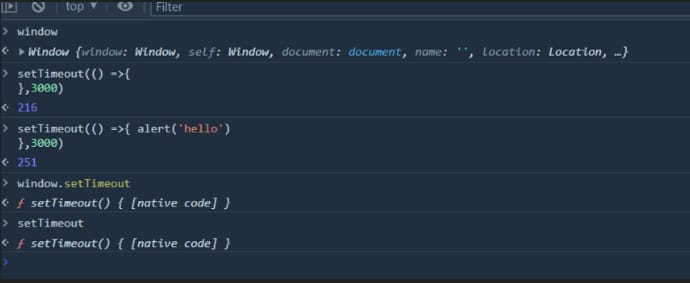Difference between running JavaScript in Browser and Node JS
In the Brower if you do a right click and go to inspect
You will find the console where if we write window , we could see window object with different properties or method such as setTimeout() , setInterval() so we just have to write property name to use it. So the window object is global in the browser.
But in Node JS, we have global object with the keyword global so if we
console.log(global)
we get
now we write
global.setTimeout(() =>{
console.log('in the timeout')
},3000)
we will get the desired output but since global is Global object so we don’t have to write global explicitly.
Two useful properties
console.log(__dirname)
// absolute path of the current folder without current file
console.log(__filename)
// absolue path of the current folder with the current file
We can’t access DOM such as querySelector in global object in node.
Module and require
In text.js
const fruits = ['apple','mango','oranges','guava'];
console.log(fruits)
create a new JS file let say module.js and type
const xyz = require('./text');
console.log(xyz)
it will give you result as
[ 'apple', 'mango', 'oranges', 'guava' ]
{}
xyz as no return value but if we add
const fruits = ['apple','mango','oranges','guava'];
console.log(fruits)
module.exports = fruits
then xyz will return
[ 'apple', 'mango', 'oranges', 'guava' ]
Another case would be if you want to export multiple values then
const fruits = ['apple','mango','oranges','guava'];
const age = [1,2,3,4,5]
console.log(fruits)
module.exports = {
fruits,
age
}
now in module.js
const xyz = require('./text');
console.log(xyz.age)
we also destructure it
const {people,age} = require('./text');
console.log(age)
Node JS also contains core module such as OS, file system(fs) , etc.
const os = require('os')
console.log(os.homedir())
File System (fs)
It is used to handle files and perform operations such as reading, writing, deleting etc.
To import this
`const fs = require('fs');`
or
Destructure this
const {readFile,writeFile} = require('fs');
using this you don’t have to use ‘fs’ as a prefix before a method
→ Reading files
fs.readFile('./docs/path.txt',(err,data)=>{
if(err)
{
console.log(err);
}
console.log(data);
})
this will give a buffer
Buffer is just a package of data that has been send towards when we read this file
so we have to convert data into string
console.log(data.toString());
Also they are asynchronous means can start long-running tasks, and continue running other tasks in parallel*.*
→ Writing files
fs.writeFile('./docs/path.txt', 'hello , everyone' , () =>{
console.log('file is wriiten');
})
It will overwrite the text in the file
→ Directories
if(!fs.existsSync('./assets')){
fs.mkdir('./assets',(err) =>{
if(err){
console.log(err);
}
else{
console.log('folder created');
}
})
}
else{
fs.rmdir('./assets',(err) =>{
if(err)
{
console.log(err);
}
console.log('folder deleted')
})
}
if the directory doesn’t exists then it will be created using mkdir else it will be deleted using rmdir.
→ deleting files
//deleting files
if(fs.existsSync('./docs/delete.txt'))
{
fs.unlink('./docs/delete.txt',(err) =>{
if(err)
{
console.log(err);
}
console.log('file deleted')
})
}
we use unlink method to delete the files
Streams and buffers
Now imagine we have a large data or file, we could wait for the file to be read completely but that could take a long time. We could pass the data in a bit of a Stream i.e. a small chunk of data that is known as a buffer and send down the stream every time a buffer fills so that you can start using the data. It is used for such as video loading.
Two types
Read streams and write streams
firstly,
const fs = require('fs');
const readStream = fs.createReadStream('./docs/path.txt', { encoding : 'utf8'});
const writeStream = fs.createWriteStream('./docs/path.txt',{flags : 'a'});
readStream.on('data',(chunk) =>{
console.log('---New Chunk----');
console.log(chunk);
writeStream.write('---New Chunk----');
writeStream.write(chunk);
})
on is a event listener to listen to the buffer of data. ‘data’ is an event in this situation like ‘click’. In the above code after reading the buffer, it rewrites the buffer with 'writeStream'. To make the process short, we can just write*
readStream.pipe(writeStream)
that s it !🙂
reference - net ninja(youtube), coding addict(youtube), google search








Top comments (0)